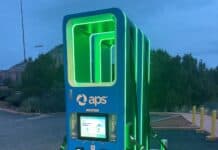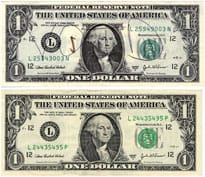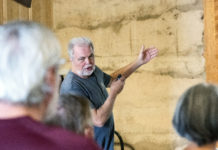John Stabe, a Cottonwood resident, walked into a convenience store Tuesday, Jan. 8, to buy a soda only to discover the dollar he attempted to pay with was fake. The day before, Stabe said he took possession of the dollar after making a purchase at a Cottonwood business — which one, he’s not quite certain.
Larson Newspapers
John Stabe, a Cottonwood resident, walked into a convenience store Tuesday, Jan. 8, to buy a soda only to discover the dollar he attempted to pay with was fake.
The day before, Stabe said he took possession of the dollar after making a purchase at a Cottonwood business — which one, he’s not quite certain.
The clerk at the Cottonwood convenience store recognized the bill as counterfeit.
With a quick swipe of a counterfeit banknote detection pen designed to identify fake money, the dollar was taken out of circulation.
The mark, which turned black, is the only thing Stabe said makes the bill look fake.
“Even looking at it right now I can’t tell it’s fake,” Stabe said. “You don’t think of a dollar bill being counterfeit.”
Cottonwood Police Chief Doug Bartosh agreed, $1 bills aren’t commonly counterfeited. Stabe’s report is the first Bartosh has received recently.
Normally, $20s and $50s are targeted, but currency updates make it harder for those bills to be duplicated.
Since September 2004, new $50s, $20s and $10s entered circulation redesigned to include background color changes, watermarks, color-shifting ink, a security strip and microprinting, or text too small to read with the naked eye.
According to moneyfactory.gov, redesigned $5 bills are set to enter circulation this year.
Bartosh said redesign may be the reason someone decided to counterfeit a $1 bill rather than a $10 or $20 bill.
The Federal Reserve Bank of San Francisco reports that since the Secret Service was formed in 1865, it drastically reduced the amount of counterfeit money in circulation. In 1865, an estimated one-third to half of the nation’s currency was counterfeit.
By 2001, the U.S. Treasury estimated less than 0.01 percent of the nation’s approximate $600-billion circulation base is fake, which means $60 million.
As for reimbursement of Stabe’s dollar, he’s out of luck.
If a person accepts a fake bill as change while shopping, no entity is required to reimburse the counterfeit currency, according to bankrate.com. If the money comes from a bank, it may choose to replace the money through customer service but it is not required
to do so.
Other Verde Valley agencies were also surprised by the report.
Sedona Police Chief Joe Vernier said SPD hadn’t received any reports of counterfeit money since fake $20 bills circulated the area approximately a year ago.
Camp Verde Marshal’s Office Administrative Assistant Darby Martin said CVMO hadn’t received any reports this time around either.
People who encounter counterfeit money are urged to call the police and file a report. The report is then turned over to the Secret Service for investigation.
According to Vernier, it can be difficult tracking down the origin of fake bills. Fingerprinting the bill to determine who has handled it doesn’t get police far either.
“Money changes hands so many times,” Vernier said.
Stabe turned the bill over to Cottonwood Police Department who will further investigate.
Trista Steers can be reached at 282-7795, Ext. 124, or e-mail to tsteers@larsonnewspapers.com






















